Citation: John D. Nagy. The Ecology and Evolutionary Biology of Cancer: A Review of Mathematical Models of Necrosis and Tumor Cell Diversity[J]. Mathematical Biosciences and Engineering, 2005, 2(2): 381-418. doi: 10.3934/mbe.2005.2.381
| [1] | Radhwane Derraz, Farrah Melissa Muharam, Noraini Ahmad Jaafar . Uncertainty sources affecting operational efficiency of ML algorithms in UAV-based precision agriculture: A 2013–2020 systematic review. AIMS Agriculture and Food, 2023, 8(2): 687-719. doi: 10.3934/agrfood.2023038 |
| [2] | Ayomikun D. Ajayi, Boris Boiarskii, Kouya Aoyagi, Hideo Hasegawa . Utilizing MapBox API, Java, and ICT in the creation of agricultural interactive maps for improved farm management and decision-making. AIMS Agriculture and Food, 2024, 9(2): 393-410. doi: 10.3934/agrfood.2024023 |
| [3] | Fernando Arias, Maytee Zambrano, Kathia Broce, Carlos Medina, Hazel Pacheco, Yerenis Nunez . Hyperspectral imaging for rice cultivation: Applications, methods and challenges. AIMS Agriculture and Food, 2021, 6(1): 273-307. doi: 10.3934/agrfood.2021018 |
| [4] | Apori Samuel Obeng, Adams Sadick, Emmanuel Hanyabui, Mohammed Musah, Murongo Marius, Mark Kwasi Acheampong . Evaluation of soil fertility status in oil palm plantations in the Western Region of Ghana. AIMS Agriculture and Food, 2020, 5(4): 938-949. doi: 10.3934/agrfood.2020.4.938 |
| [5] | Thamires Monteiro Silva Maués, Rafael Rodrigo da Silva Costa, Marcos Antônio Souza dos Santos, Gisele Barata da Silva . Agroeconomic performance of banana tree under nutritional management with Trichoderma asperellum, in a family production system. AIMS Agriculture and Food, 2022, 7(2): 297-311. doi: 10.3934/agrfood.2022019 |
| [6] | Janice Liang, Travis Reynolds, Alemayehu Wassie, Cathy Collins, Atalel Wubalem . Effects of exotic Eucalyptus spp. plantations on soil properties in and around sacred natural sites in the northern Ethiopian Highlands. AIMS Agriculture and Food, 2016, 1(2): 175-193. doi: 10.3934/agrfood.2016.2.175 |
| [7] | Elizabeth Ramírez-Iglesias, Rosa M. Hernández-Hernández, Carlos Bravo, José R. Ramírez-Iglesias, Pablo Herrera . Consumption, digestibility and cattle condition according to forage composition and quality in maize-cattle from conservation-based agroecosystems. AIMS Agriculture and Food, 2020, 5(3): 480-499. doi: 10.3934/agrfood.2020.3.480 |
| [8] | Ogunniyi Adebayo, Omonona Bolarin, Abioye Oyewale, Olagunju Kehinde . Impact of irrigation technology use on crop yield, crop income and household food security in Nigeria: A treatment effect approach. AIMS Agriculture and Food, 2018, 3(2): 154-171. doi: 10.3934/agrfood.2018.2.154 |
| [9] | Joana Simões, Carolina Marmota, Lisa Moreira, Daniela V. T. A. Costa, Helena E. Correia, António Pinto, Dulcineia Wessel, Fernanda Delgado, João P. Carneiro, Carmo Horta, Kiril Bahcevandziev, Maria M. B. Vidal, Olga M. S. Filipe, Cristina Amaro da Costa . Biostimulants in organic vegetable nurseries: Study case in lettuce. AIMS Agriculture and Food, 2024, 9(3): 842-855. doi: 10.3934/agrfood.2024045 |
| [10] | Shahram Torabian, Ruijun Qin, Christos Noulas, Yanyan Lu, Guojie Wang . Biochar: an organic amendment to crops and an environmental solution. AIMS Agriculture and Food, 2021, 6(1): 401-415. doi: 10.3934/agrfood.2021024 |
The production of lignocellulosic biomass obtained from forest crops is a primary source of renewable energy to meet the current energy targets of European legislation [1]. Among the tree species, poplar is considered to have great potential for biomass production because its rapid growth, broad genetic base, ease of vegetative propagation, and ability to regrow after cutting [2]. Conventional methods for calculating dry biomass of poplar trees by non-destructive methods use empirical equations related to tree height, and eventually trunk dimensions, which require manual measurements of the trees that are costly due to tedious fieldwork and generally inaccurate due to human errors during field measurements and the uncertainty inherent in their empirical nature [3].
Currently, Unmanned Aerial Vehicles (UAV) technology is an alternative to the manual collection of crop data, offering information on variables and factors affecting crop development and productivity with relatively shorter time and lower cost [4,5,6]. Together with the spectral information contained in the remote sensing images taken with very high spatial resolution (<10 cm/pixel), UAVs also allow the generation of a Digital Surface Model (DSM) with three-dimensional (3D) crop information, which is obtained as a result of applying a Structure from Motion (SfM) technique [7]. The SfM algorithm works by matching equal pairs of points located on overlapping images, so correct generation of the DSM depends on the quality of the UAV images and the ease of detecting such points, which could be improved by optimizing the values of image contrast, saturation and brightness [8].
The DSM reflects the irregular geometry of the crop and provides detailed information on crop dimensions, opening up new opportunities to monitor crop growth if the measurements are available over time [9,10]. Among the data that can be obtained from the DSM, plant or tree height is an indicator of crop vigor and, either alone or in combination with certain vegetation indices (e.g., the Normalized Difference Vegetation Index, NDVI), is considered a good predictor of crop biomass and yield [11,12,13].
Previous research has reported successful applications of UAV-based monitoring of horticultural crops [14,15,16] and forest structures [17,18], although its application to poplar has not been investigated so far. Therefore, this paper evaluated the use of UAV-based images in a poplar plantation with two main objectives: (a) to assess tree heights from DSMs generated with images collected with a conventional visible-light camera, and (b) to estimate crop dry biomass by combining DSM-based height data and NDVI information obtained with a multispectral camera. An additional objective was to determine the influence of different enhancement adjustments applied to the original UAV images on the DSM quality and on its accuracy of tree height estimations. The ultimate goal was to propose a rapid, non-destructive and relatively accurate procedure for monitoring the size and biomass of hundreds of poplar trees using an innovative technology.
This investigation was carried out in a poplar plantation located at La Poveda experimental farm in Arganda del Rey, Madrid (Spain), with central coordinates 458,460 m X and 4,463,260 m Y (UTM system, zone 30 N, datum WGS84). This farm is flat and its soil has a sandy-loam texture. The climate in this region is Mediterranean Continental with cold winters and hot summers (mean daily temperature 13.5 ℃), and an annual cumulative rainfall of 400 mm. The poplar plantation was established on April 2013 in an area of 5700 m2 (95 m length and 60 m width), as part of a broad research program focused to study the adaptation of this crop to different management strategies [19], in which obtaining measurements of tree height and crop biomass is essential. The poplar trees were planted in high-density at 3 m apart and 0.5 m between trees, in a block design made up of 4 blocks and 19 tree-rows in each block, resulting in a density of 6666 tree/ha (Figure 1).
 Figure 1. Field photograph of the experimental poplar plantation on the day of the UAV flights.
Figure 1. Field photograph of the experimental poplar plantation on the day of the UAV flights.The UAV used to take the images was a quadricopter MD4-1000 (microdrones GmbH, Siegen, Germany) with vertical take-off and landing, payload of 1.25 kg, and with ability for autonomous flights during 40–45 minutes following a route previously programmed (Figure 2). The images were acquired on October 2013 at 100 m flight altitude with forward overlapping of 80% and side overlapping of 60%. Two different cameras were mounted separately in the UAV. A conventional visible-light camera, model Olympus PEN E-PM1 (Olympus Corporation, Tokyo, Japan), which acquired 12-megapixel images in Red-Green-Blue (RGB) color, and a multi-spectral camera, model Tetracam mini-MCA-6 (Tetracam Inc., Chatsworth, CA, USA), which acquired 1.3-megapixel images composed of six individual digital channels with center wavelengths at B (450 nm), G (530 nm), R (670 and 700 nm), R edge (740 nm) and near-infrared (NIR, 780 nm). The spatial resolution obtained with each camera was 3.8 cm and 5.6 cm, respectively. The former camera was used to generate the DSM of the poplar plantation with 3D information of the trees, while the latter camera was used to obtain the NDVI values of the poplar trees by using the R and NIR bands (Eq 1). Detailed information about the UAV-based system and the influence of flight configuration on image quality is reported in [20,21,22].
| NDVI=(NIR−Red)/(NIR+Red) | (1) |
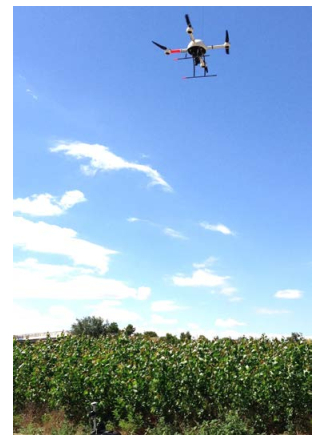 Figure 2. The UAV with the multi-spectral camera flying towards the poplar plantation.
Figure 2. The UAV with the multi-spectral camera flying towards the poplar plantation.The remote sensing images collected with both cameras were separately processed in order to generate a unique mosaicked image of the entire plantation, with spectral (from the multi-spectral camera) and 3D information (from the DSM obtained with the RGB camera) of the poplar trees (Figure 3). The mosaicking process was carried out with the Agisoft PhotoScan Professional Edition software (Agisoft LLC, St. Petersburg, Russia), by applying three consecutive phases of alignment of the overlapping images, construction of the field geometry, and generation of the ortho-image, the point cloud and the DSM with the SfM technique [18]. For the task of geo-referencing, six ground control points located in the corners and center of the poplar plantation were used, whose coordinates were taken with a GPS device after the UAV flight. The multi-spectral ortho-images had the R and NIR spectral bands for the calculation of an NDVI image, while the DSM is a polygon mesh adjusted to the raw point cloud and that represented the tree crowns. We used the most rigorous settings for the process of DSM generation (i.e., using the features "Face count: High", "Point classes: All"), which resulted to a good adjustment of the polygon mesh to the upper envelope of the point cloud with minimal differences between both products. These geo-spatial products were exported to the image analysis software eCognition Developer versión 9 (Trimble GeoSpatial, Munich, Germany), which was used to calculate the tree dimensions (i.e., area, height and volume) and the average NDVI value of every tree in the poplar plantation by applying a customized object-based image analysis (OBIA) algorithm adapted to this investigation from the procedure developed in [15,23].
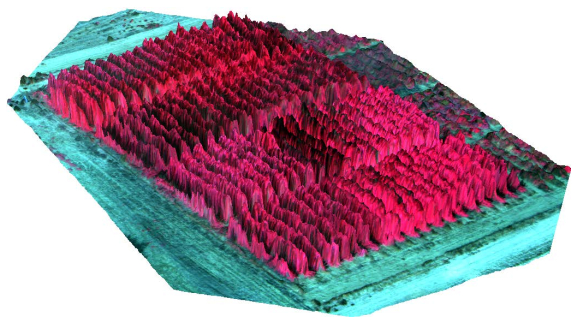 Figure 3. UAV-based geo-spatial product of the poplar plantation created by combining the DSM from the RGB camera and the color-infrared ortho-mosaic image from the multi-spectral camera.
Figure 3. UAV-based geo-spatial product of the poplar plantation created by combining the DSM from the RGB camera and the color-infrared ortho-mosaic image from the multi-spectral camera.Additionally, six different settings of green saturation, brightness and contrast were applied to the original RGB images with the objective of increasing image enhancement (Table 1). These operations were proposed after a preliminary study in which we observed a general improvement of the DSM if the original UAV images are previously enhanced. These adjustments were performed before image mosaicking with the Adobe Photoshop software (Adobe Systems, San Jose, CA, USA).
| Adjustment | Green Saturation (%) | Brightness (%) | Contrast (%) |
| 0 | - | - | - |
| 1 | 100 | 80 | - |
| 2 | 100 × 2 | 80 × 2 | - |
| 3 | 100 | 80 | 100 |
| 4 | 100 | - | 100 |
| 5 | - | - | 100 |
| 6 | 100 | - | - |
In order to validate the measurements of the UAV-based system, non-destructive manual sampling of tree heights and dry biomass was performed in a number of trees spaced apart from the edges of each block. The tree heights were measured on-ground with a ruler, and dry biomass was estimated with an allometric equation (Eq 2) commonly used for estimating shoot biomass in poplar species by combining trunk diameter at breast height squared by total tree height [3,24]. The validation set was composed of 48 tree-rows, with 20 trees each row. The experimental design is schematized in the figure 4 and the descriptive statistics of the validation trees is shown in the Table 2.
| Biomass=a(Trunk−Diameter)2Tree−Height | (2) |
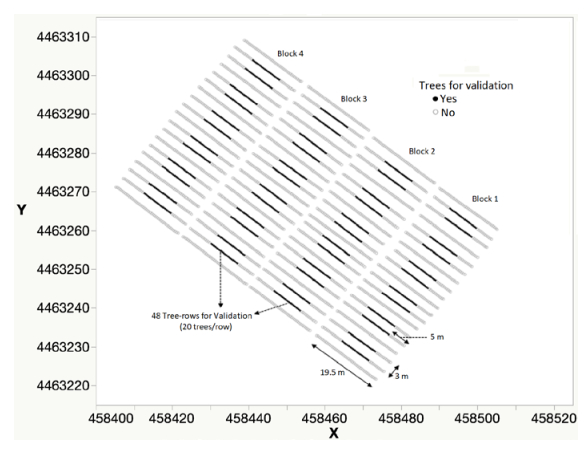 Figure 4. Graphical scheme of the poplar plantation and the position of the tree-rows used for validation.
Figure 4. Graphical scheme of the poplar plantation and the position of the tree-rows used for validation.| Statistic | Tree height (m) | Trunk Diameter (cm) | Dry Biomass (kg/m2) |
| Min | 3.00 | 2.30 | 0.35 |
| Max | 6.95 | 7.30 | 7.94 |
| Mean | 4.27 | 4.15 | 1.68 |
| Std. Dev. | 0.58 | 0.72 | 0.83 |
DSM accuracy in defining the tree-row structure was assessed by comparing the real tree heights observed in the validation tree-rows and the heights estimated by the DSMs obtained from each adjustment defined in the Table 1. The DSM estimations were considered correct if the differences with the actual heights were less than 1 m, thus eliminating the errors associated with the thin apex of the upper part of the trees that was not detected by the DSM in most cases. These thin apexes provide little biomass to the trees and therefore do not influence the overall biomass estimations. Also, DMS estimations lower than half of the actual tree heights were considered incorrect and the rest were considered underestimated.
The DSM that reported best results in the previous evaluation was then selected to compute and map the tree dimensions (in height and volume) of the entire plantation. These data were joined to the NDVI values of every poplar tree reported by the multi-spectral ortho-mosaicked image. Each individual variable and the fusion of NDVI with height and volume, separately, were studied with the objective of establishing linear regression models for estimating tree height and crop biomass at the scale of tree-rows.
The results were shown in scatter plots and evaluated based on their root mean square error (RMSE) and their coefficient of determination (R2). Data analysis was conducted with the statistical software JMP version 10 software (SAS Institute Inc., Cary, NC, USA).
Image enhancement previous to the generation of the DSM provided better estimations of actual tree heights in all the cases in comparison to the use of the original untreated images (Table 3), increasing the accuracy from 65% (settings 0, no image enhancement) to values between 84% (settings 1 and 3) and 86% (settings 2 and 4). As example, height profiles of a transverse line passing through the poplar plantation show the several DSM reconstructions as a result of applying each adjustment (Figure 5). Differences between the accuracy reached in each adjustment were minimal, so it cannot be concluded with the recommendation of any specific settings, although the high improvement of the DSM as a result of applying an image enhancement procedure prior to the mosaic was notable.
| Adjustment | Accuracy (%) | ||
| Incorrect | Under-estimated | Correct | |
| 0 | 9 | 26 | 65 |
| 1 | 0 | 15 | 84 |
| 2 | 0 | 14 | 86 |
| 3 | 0 | 15 | 84 |
| 4 | 0 | 14 | 86 |
| 5 | 0 | 15 | 85 |
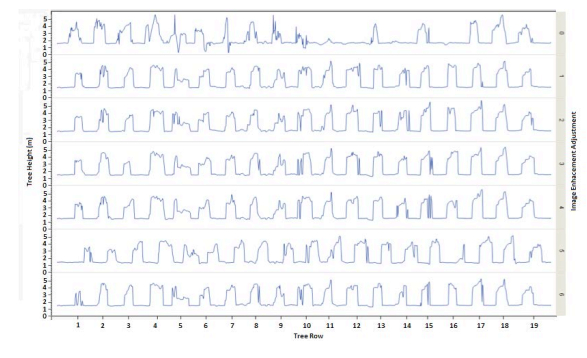 Figure 5. Height profiles showing the several DSM reconstructions as a result of applying each image enhancement adjustment.
Figure 5. Height profiles showing the several DSM reconstructions as a result of applying each image enhancement adjustment.The DSM generated with the image-enhancement settings number 4 was finally selected to compute the tree heights and volumes of the entire plantation, which were also used to estimate crop biomass in combination with the NDVI data obtained from the multi-spectral image. First, we compare the DSM-based height estimations to the on-ground height measurements of the 48 validation tree-rows and obtained that both variables were correlated with a R2 of 0.599, although DSM data generally underestimated actual heights 1–2 m on average. As noted above, the reason was because the DSM did not detect the fine apexes at the top of the trees, which on the contrary, were considered in the on-ground validation measurements. Therefore, due to the typical structure of the poplar trees, increasing DSM-based measurements with the average length of the apex (1 meter in this case) gave a better predictor of the actual tree height, with a RMSE of 0.21 m (Figure 6).
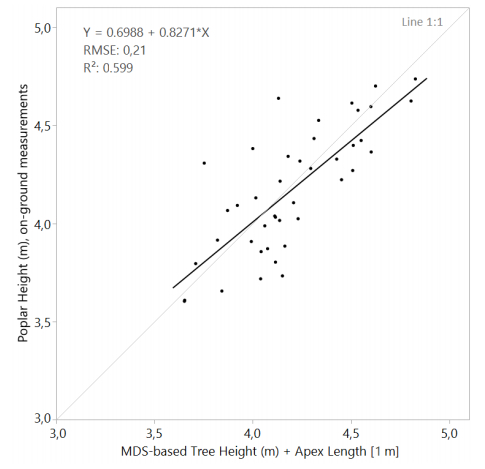 Figure 6. Scatter plot and linear regression of UAV-based estimations of tree heights and the actual tree heights.
Figure 6. Scatter plot and linear regression of UAV-based estimations of tree heights and the actual tree heights.Next, linear regression equations were developed to study the ability of the UAV-based system to estimate poplar tree dry biomass (Table 4). The best results were obtained with the fusion of NDVI data and tree height estimations (NDVI * Height), which yielded a R2 of 0.540 and a RMSE of 0.23 kg/m2 (Figure 7a), which was better than the results reported with height data alone (R2 = 0.446, RMSE = 0.25 kg/m2) (Figure 7b). It was also noticed that regressions that included the volume variable produced poorer results than expected (Figure 7c, d), perhaps due to errors associated to the DSM reconstruction of the tree crowns, which consequently, caused inconsistent measurements of tree volume. On-ground validation of tree volume measurements is complex and we did not include this validation in our investigation, so further studies are needed to support these results.
| Regression equation | R2 | RMSE (kg/m2) |
| Biomass = 0.01 + 0.52 (NDVI * Height) | 0.540 | 0.23 |
| Biomass = –0.14 + 0.74 Height | 0.446 | 0.25 |
| Biomass = 0.89 + 0.48 (NDVI * Volume) | 0.417 | 0.26 |
| Biomass = 0.92 + 0.30 Volume | 0.344 | 0.27 |
| Biomass = –1.08 + 4.08 NDVI | 0.247 | 0.29 |
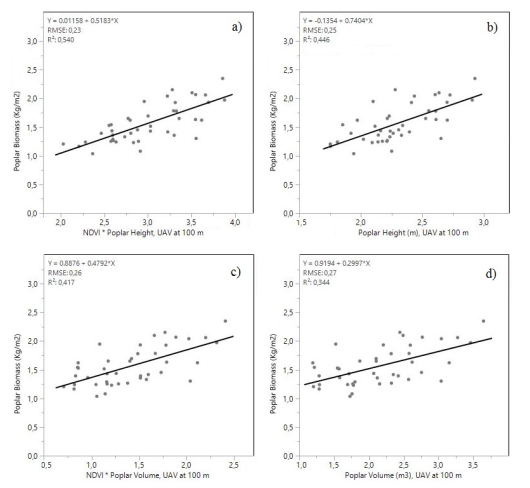 Figure 7. Scatter plots and linear regressions for estimating poplar dry biomass from UAV-based estimations: (a) NDVI * Poplar height, (b) Poplar height, (c) NDVI * Poplar volume, (d) Poplar volume.
Figure 7. Scatter plots and linear regressions for estimating poplar dry biomass from UAV-based estimations: (a) NDVI * Poplar height, (b) Poplar height, (c) NDVI * Poplar volume, (d) Poplar volume.Previous investigations have reported the good performance of fusing NDVI and crop height to estimate crop biomass [12,25], as these variables are good indicators of canopy density and tree size, respectively. However, NDVI showed a low correlation to crop biomass in our experiment (R2 = 0.247), although this index improved the performance of DSM-based tree height as estimator of crop biomass about 20%. The spatial pattern of NDVI values (Figure 8a) were generally different from that of DSM-based tree heights (Figure 8b), as NDVI was higher in the northern parts of each block, while distribution of tree heights was balanced in all the four blocks, although the trees were generally higher in the center of the plantation, particularly in blocks 2 and 3. The result of combining both variables marked the trees with the highest values of NDVI and height, and therefore with the highest dry biomass, which were located on the left side of block 3 and in a small area of blocks 2 and 4 (Figure 8c). The low values observed at the edges of the plantation were attributed to errors in DSM reconstruction rather than on-ground measurements or model estimations.
 Figure 8. Variability of NDVI values, (a) DSM-based tree heights, (b) and modeled dry biomass, (c) in the entire poplar plantation.
Figure 8. Variability of NDVI values, (a) DSM-based tree heights, (b) and modeled dry biomass, (c) in the entire poplar plantation.Our results are in line with those obtained in other research on woody crops, although accuracy varies according to the type of crop and the structure of the plantation [26]. For example, [23,27] in vineyard, [15,28] in olive orchards and [29] in palm trees modeled the irregular architecture of the tree crowns with UAV technology and derived the tree heights, and the tree volume in some cases, with low errors in the range of a few centimeters (RMSE between 9.8 cm and 59.0 cm). Additionally, the DSM data alone or in combination with spectral information (generally, with the NDVI) were also used to retrieve crop biomass. In annual crops, [30] in eggplant, tomato, and cabbage crops and [11] in barley used UAV imagery to assess crop height during different growth stages with a very high accuracy (maximum R2 of 0.97 and of 0.92, respectively) and, by applying machine learning methods or regression models with these UAV-based height data, respectively, retrieved crop biomass variability (R2 of 0.88–0.95 and of 0.31–0.72, respectively). Despite the good results, [11] reported same problems due to crop lodging during senescence stages. Similar conclusions were reached by [31] in a phenotyping experiment in wheat, who also pointed out that UAV-based crop measurements are often underestimated due to the limited penetration capacity of the SfM technique and the coarse spatial resolution of UAV imagery in comparison to several crop details. Other factors that affected DSM quality (and consequently, estimations of tree dimensions and crop biomass) were crop movement due to wind [11] and specifications on UAV flight configuration regarding to image overlapping [32], UAV flight altitude [15], and flight modes [21]. All these factors probably had a significant influence on our experiment, as the tree apexes and part of the lateral branching were not detected correctly, resulting in moderate results in computing tree height and volume, respectively. It should also be noted that manual measurements are often an approximation of the exact size of the trees based on a visual estimate and therefore often have a margin of error. In this sense, the objective of obtaining a high correlation (in terms of high R2 or low RMSE) between manual and UAV measurements is not the perfect solution, although it does provide very valuable information on the capability of the UAV to obtain measurements similar to those that would be obtained on the ground.
This paper demonstrated the capability of UAV technology to monitor poplar plantation at the field scale. Regression equations for estimating tree heights and biomass achieved acceptable correlations (R2 of 0.599 and 0.540, respectively) and low errors (RMSE of 0.21 cm and 0.23 kg/m2, respectively), In total, we obtained UAV-based data (NDVI and tree dimensions) of the entire plantation (about 3350 poplar trees) with relatively low effort (i.e., 2 hours approximately) in comparison to the work needed for conventional manual measurements. However, further studies are needed in other fields and crop conditions, as well in several years to confirm transferability and to limit the above-mentioned uncertainties.
This research was financed by the AGL2014-52465-C4 and the AGL2017-83325-C4 projects (Spanish Ministry of Economy, Industry and Competitiveness and EU-FEDER funds). Research of Dr. Peña, Dr. Andújar and Dr. de Castro were financed by the Ramon y Cajal (grant numbers RYC-2013-14874 and RYC-2016-20355) and the Juan de la Cierva projects, respectively, of the Spanish Ministry of Economy, Industry and Competitiveness.
The authors declare no conflict of interest.
| 1. | Daniel Olson, James Anderson, Review on unmanned aerial vehicles, remote sensors, imagery processing, and their applications in agriculture, 2021, 0002-1962, 10.1002/agj2.20595 | |
| 2. | Joe Mari J. Maja, James Robbins, The next generation of Precision Horticulture Technologies, 2019, 4, 2471-2086, 111, 10.3934/agrfood.2019.1.111 | |
| 3. | Fernando Coelho Eugenio, Cristine Tagliapietra Schons, Caroline Lorenci Mallmann, Mateus Sabadi Schuh, Pablo Fernandes, Tiago Luis Badin, Remotely piloted aircraft systems and forests: a global state of the art and future challenges, 2020, 50, 0045-5067, 705, 10.1139/cjfr-2019-0375 | |
| 4. | Comparison of UAV Photogrammetry and 3D Modeling Techniques with Other Currently Used Methods for Estimation of the Tree Row Volume of a Super-High-Density Olive Orchard, 2019, 9, 2077-0472, 233, 10.3390/agriculture9110233 | |
| 5. | Lei Feng, Shuangshuang Chen, Chu Zhang, Yanchao Zhang, Yong He, A comprehensive review on recent applications of unmanned aerial vehicle remote sensing with various sensors for high-throughput plant phenotyping, 2021, 182, 01681699, 106033, 10.1016/j.compag.2021.106033 | |
| 6. | Riccardo Dainelli, Piero Toscano, Salvatore Filippo Di Gennaro, Alessandro Matese, Recent Advances in Unmanned Aerial Vehicle Forest Remote Sensing—A Systematic Review. Part I: A General Framework, 2021, 12, 1999-4907, 327, 10.3390/f12030327 | |
| 7. | Yuanhui Zhu, Kai Liu, Soe W. Myint, Zhenyu Du, Yubin Li, Jingjing Cao, Lin Liu, Zhifeng Wu, Integration of GF2 Optical, GF3 SAR, and UAV Data for Estimating Aboveground Biomass of China’s Largest Artificially Planted Mangroves, 2020, 12, 2072-4292, 2039, 10.3390/rs12122039 | |
| 8. | Ana I. de Castro, Pilar Rallo, María Paz Suárez, Jorge Torres-Sánchez, Laura Casanova, Francisco M. Jiménez-Brenes, Ana Morales-Sillero, María Rocío Jiménez, Francisca López-Granados, High-Throughput System for the Early Quantification of Major Architectural Traits in Olive Breeding Trials Using UAV Images and OBIA Techniques, 2019, 10, 1664-462X, 10.3389/fpls.2019.01472 | |
| 9. | Lucy G. Poley, Gregory J. McDermid, A Systematic Review of the Factors Influencing the Estimation of Vegetation Aboveground Biomass Using Unmanned Aerial Systems, 2020, 12, 2072-4292, 1052, 10.3390/rs12071052 | |
| 10. | Serdar Selim, Mustafa Kalaycı, Ali Kılçık, Obtaining Height Information Using a 2-D Top View UAV Image with the Help of Spherical Astronomy, 2020, 48, 0255-660X, 1083, 10.1007/s12524-020-01139-y | |
| 11. | Pilar Rallo, Ana I. de Castro, Francisca López-Granados, Ana Morales-Sillero, Jorge Torres-Sánchez, María Rocío Jiménez, Francisco M. Jiménez-Brenes, Laura Casanova, María Paz Suárez, Exploring UAV-imagery to support genotype selection in olive breeding programs, 2020, 273, 03044238, 109615, 10.1016/j.scienta.2020.109615 | |
| 12. | Mojdeh Miraki, Hormoz Sohrabi, Parviz Fatehi, Mathias Kneubuehler, Individual tree crown delineation from high-resolution UAV images in broadleaf forest, 2021, 61, 15749541, 101207, 10.1016/j.ecoinf.2020.101207 | |
| 13. | J.M. Peña, F.J. Ostos-Garrido, J. Torres-Sánchez, F. Pistón, A.I. de Castro, 2019, A UAV-based system for monitoring crop growth in wheat, barley and triticale phenotyping field trials, 978-90-8686-337-2, 397, 10.3920/978-90-8686-888-9_49 | |
| 14. | Lucy G. Poley, David N. Laskin, Gregory J. McDermid, Quantifying Aboveground Biomass of Shrubs Using Spectral and Structural Metrics Derived from UAS Imagery, 2020, 12, 2072-4292, 2199, 10.3390/rs12142199 | |
| 15. | Riccardo Dainelli, Piero Toscano, Salvatore Filippo Di Gennaro, Alessandro Matese, Recent Advances in Unmanned Aerial Vehicles Forest Remote Sensing—A Systematic Review. Part II: Research Applications, 2021, 12, 1999-4907, 397, 10.3390/f12040397 | |
| 16. | Yahui Guo, Yi Xiao, MingWei Li, Fanghua Hao, Xuan Zhang, Hongyong Sun, Kirsten de Beurs, Yongshuo H. Fu, Yuhong He, Identifying crop phenology using maize height constructed from multi-sources images, 2022, 115, 15698432, 103121, 10.1016/j.jag.2022.103121 | |
| 17. | Aravind Harikumar, Petra D’Odorico, Ingo Ensminger, Combining Spectral, Spatial-Contextual, and Structural Information in Multispectral UAV Data for Spruce Crown Delineation, 2022, 14, 2072-4292, 2044, 10.3390/rs14092044 | |
| 18. | Seyed Arvin Fakhri, Hooman Latifi, A Consumer Grade UAV-Based Framework to Estimate Structural Attributes of Coppice and High Oak Forest Stands in Semi-Arid Regions, 2021, 13, 2072-4292, 4367, 10.3390/rs13214367 | |
| 19. | Javier Hernández-Cole, Edgar Ortiz-Malavassi, Roger Moya, Olmán Murillo, Evaluation of Unmanned Aerial Vehicles (UAV) as a Tool to Predict Biomass and Carbon of Tectona grandis in Silvopastoral Systems (SPS) in Costa Rica, 2021, 5, 2504-446X, 47, 10.3390/drones5020047 | |
| 20. | Mojdeh Miraki, Hormoz Sohrabi, Parviz Fatehi, Mathias Kneubuehler, Detection of mistletoe infected trees using UAV high spatial resolution images, 2021, 128, 1861-3829, 1679, 10.1007/s41348-021-00502-6 | |
| 21. | Pratyasha Singh, Aparupa Pani, Arun S. Mujumdar, Shivanand S. Shirkole, New strategies on the application of artificial intelligence in the field of phytoremediation, 2023, 25, 1522-6514, 505, 10.1080/15226514.2022.2090500 | |
| 22. | Chris D. Hasselerharm, Esty Yanco, Jeannine S. McManus, Bool H. Smuts, Daniel Ramp, Wildlife-friendly farming recouples grazing regimes to stimulate recovery in semi-arid rangelands, 2021, 788, 00489697, 147602, 10.1016/j.scitotenv.2021.147602 | |
| 23. | Kai O. Bergmüller, Mark C. Vanderwel, Evaluating Effects of Remotely Sensed Neighborhood Crowding and Depth-to-Water on Tree Height Growth, 2023, 14, 1999-4907, 242, 10.3390/f14020242 | |
| 24. | Qiuli Yang, Yanjun Su, Tianyu Hu, Shichao Jin, Xiaoqiang Liu, Chunyue Niu, Zhonghua Liu, Maggi Kelly, Jianxin Wei, Qinghua Guo, Allometry-based estimation of forest aboveground biomass combining LiDAR canopy height attributes and optical spectral indexes, 2022, 9, 21975620, 100059, 10.1016/j.fecs.2022.100059 | |
| 25. | Aliasghar Bazrafkan, Nadia Delavarpour, Peter G. Oduor, Nonoy Bandillo, Paulo Flores, An Overview of Using Unmanned Aerial System Mounted Sensors to Measure Plant Above-Ground Biomass, 2023, 15, 2072-4292, 3543, 10.3390/rs15143543 | |
| 26. | Geronimo Quiñonez-Barraza, Marin Pompa-García, Eduardo Daniel Vivar-Vivar, José Luis Gallardo-Salazar, Francisco Javier-Hernández, Felipa de Jesús Rodríguez-Flores, Raúl Solís-Moreno, Javier Leonardo Bretado-Velázquez, Ricardo David Valdez-Cepeda, José Ciro Hernández-Díaz, Modeling Biometric Attributes from Tree Height Using Unmanned Aerial Vehicles (UAV) in Natural Forest Stands, 2023, 43, 2248-8723, e98945, 10.15446/ing.investig.98945 | |
| 27. | Mojdeh Miraki, Hormoz Sohrabi, Parviz Fatehi, Mathias Kneubuehler, Coupling UAV and satellite data for tree species identification to map the distribution of Caspian poplar, 2024, 39, 1572-9761, 10.1007/s10980-024-01846-8 | |
| 28. | Sinan Bulut, Alkan Günlü, Hasan Aksoy, Ferhat Bolat, Mücahit Yılmaz Sönmez, Integration of field measurements with unmanned aerial vehicle to predict forest inventory metrics at tree and stand scales in natural pure Crimean pine forests, 2024, 45, 0143-1161, 3872, 10.1080/01431161.2024.2357837 | |
| 29. | Dangui Lu, Yuan Chen, Zhongke Feng, Zhichao Wang, Assessment of Carbon Sink and Carbon Flux in Forest Ecosystems: Instrumentation and the Influence of Seasonal Changes, 2024, 16, 2072-4292, 2293, 10.3390/rs16132293 | |
| 30. | Estimating canopy and stand structure in hybrid poplar plantations from multispectral UAV imagery, 2024, 67, 20652445, 143, 10.15287/afr.2024.3636 | |
| 31. | Mojdeh Miraki, Hormoz Sohrabi, Markus Immitzer, Estimating biomass and carbon storage of mangrove forests using UAV-image-derived variables, 2024, 13, 0301-7591, 1, 10.61186/jgst.13.3.1 |
| Adjustment | Green Saturation (%) | Brightness (%) | Contrast (%) |
| 0 | - | - | - |
| 1 | 100 | 80 | - |
| 2 | 100 × 2 | 80 × 2 | - |
| 3 | 100 | 80 | 100 |
| 4 | 100 | - | 100 |
| 5 | - | - | 100 |
| 6 | 100 | - | - |
| Statistic | Tree height (m) | Trunk Diameter (cm) | Dry Biomass (kg/m2) |
| Min | 3.00 | 2.30 | 0.35 |
| Max | 6.95 | 7.30 | 7.94 |
| Mean | 4.27 | 4.15 | 1.68 |
| Std. Dev. | 0.58 | 0.72 | 0.83 |
| Adjustment | Accuracy (%) | ||
| Incorrect | Under-estimated | Correct | |
| 0 | 9 | 26 | 65 |
| 1 | 0 | 15 | 84 |
| 2 | 0 | 14 | 86 |
| 3 | 0 | 15 | 84 |
| 4 | 0 | 14 | 86 |
| 5 | 0 | 15 | 85 |
| Regression equation | R2 | RMSE (kg/m2) |
| Biomass = 0.01 + 0.52 (NDVI * Height) | 0.540 | 0.23 |
| Biomass = –0.14 + 0.74 Height | 0.446 | 0.25 |
| Biomass = 0.89 + 0.48 (NDVI * Volume) | 0.417 | 0.26 |
| Biomass = 0.92 + 0.30 Volume | 0.344 | 0.27 |
| Biomass = –1.08 + 4.08 NDVI | 0.247 | 0.29 |
| Adjustment | Green Saturation (%) | Brightness (%) | Contrast (%) |
| 0 | - | - | - |
| 1 | 100 | 80 | - |
| 2 | 100 × 2 | 80 × 2 | - |
| 3 | 100 | 80 | 100 |
| 4 | 100 | - | 100 |
| 5 | - | - | 100 |
| 6 | 100 | - | - |
| Statistic | Tree height (m) | Trunk Diameter (cm) | Dry Biomass (kg/m2) |
| Min | 3.00 | 2.30 | 0.35 |
| Max | 6.95 | 7.30 | 7.94 |
| Mean | 4.27 | 4.15 | 1.68 |
| Std. Dev. | 0.58 | 0.72 | 0.83 |
| Adjustment | Accuracy (%) | ||
| Incorrect | Under-estimated | Correct | |
| 0 | 9 | 26 | 65 |
| 1 | 0 | 15 | 84 |
| 2 | 0 | 14 | 86 |
| 3 | 0 | 15 | 84 |
| 4 | 0 | 14 | 86 |
| 5 | 0 | 15 | 85 |
| Regression equation | R2 | RMSE (kg/m2) |
| Biomass = 0.01 + 0.52 (NDVI * Height) | 0.540 | 0.23 |
| Biomass = –0.14 + 0.74 Height | 0.446 | 0.25 |
| Biomass = 0.89 + 0.48 (NDVI * Volume) | 0.417 | 0.26 |
| Biomass = 0.92 + 0.30 Volume | 0.344 | 0.27 |
| Biomass = –1.08 + 4.08 NDVI | 0.247 | 0.29 |